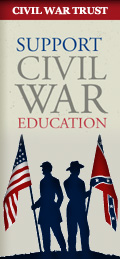Every picture tells a story
By Kathy McCabe
For nearly 150 years, the stories of the American Civil War have provided the basis for thousands of books recording the war's bloody history. Authors have been captivated by accounts of battles, the motivations of generals, and occasionally the actions of a single soldier. But for author Ronald S. Coddington, it wasn't the stories but rather the faces that inspired him to write about the lives of 77 ordinary Union soldiers.
It all started at a New Jersey flea market in 1977. Fourteen-year-old Coddington, a budding artist, was learning how to draw faces. For four dollars, he bought an antique photograph of a Civil War soldier and, later in the week, drew the soldier's likeness in his sketchbook. He began to collect these photos, known as cartes de visite, in much the same way his friends were collecting baseball cards. "I think subconsciously I was influenced by the size of the photo and the size of the baseball card. They're the same," he says.
Invented in 1854 by a French photographer, the carte de visite was a smal photographic print that could be made in duplicate. The format arrived in America on the eve of the Civil War and soldiers took advantage of the convenient and affordable photos to record their likeness before going off to battle. While many of these portrait cards still survive, a far smaler number actually record the identity of the soldier pictured.
More than 25 years as 2,000 cartes de visite later, Coddington has identified 77 of these volunteer soldiers and told each man's life story in Faces of the Civil War: An Album of Union Soldiers and Their Stories (Johns Hopkins University Press). A blown-up copy of each carte de visite accompanies several pages of text telling of the soldier's background, war experience, and post-war life. Over 300 footnotes record where Coddington got his information.
"I used to read a sentence or two in a book about a color bearer in such-and-such battle and that would be all it said about him," Coddington says. "I liked the idea of being able to flip that and put their Civil War story in context of their life. I know what happened to the generals and politicians. I know the outcomes of the battles. The Civil War is one big story but also millions of small stories."
Coddington, who is now a graphic artist, chose he subjects based on the quality of the photograph and whether the soldier's name and rank was written on the back. Sometimes, the photograph also provided a ead with the name and hometown of the photographer. Occasionally, Coddington would come upon a soldier with a very common name and had to decipher whose photo he had. He began to make weekly visits to the Library of Congress not far from his home. The military service files of the soldiers, which included muster records, prisoner of war records, and pension applications, provided a bonanza of facts about the soldiers. Just handling the pieces of aged paper made Coddington feel closer to his subjects.
It took him four years to complete the book while also working full-time. "The same amount of time it took to fight the Civil War," he notes.
Coddington can't imagine writing this book without the use of the Internet. He scoured Web sites devoted to individual regiments and located libraries and collections housing some of the soldiers' letters. fter posting a query on a genealogy Web site, the author was in touch with a subject's descendant in about 24 hours. Coddington has now met about a dozen descendants of the men.
The Internet has also helped him tell the old soldiers' stories in a new way. On the companion Web site to the book, www.facesofwar.com, Coddington has created informational graphics (like the ones he creates in his full-time job at usatoday.com) giving a statistical analysis of his subjects. ne graphic shows that his subjects' average life span was surprisingly high at 65 years.
Yet the story of one soldier who died young is the one that lingers with the author. It happens t be the first carte de visite he ever researched. Coddington located the military service file fr insurance man Edward Washburn, a captain in the Fifty-Third Massachusetts Infantry. Medical records said that Washburn suffered a severe log injury but left the army with a prognosis for a full recovery. "I just assumed he lived and continued his life and had a family," Coddington notes. But the regimental history that the author soon found told him that Washburn's life had a much sadder ending. About a year later, with Washburn anxious to return to the war, his wound broke open, blood poisoning set in, and Washburn died 10 days later after enduring great pain.
The surprises have continued. When he brought a galley of his book into work, his coworker decided to look for her great-great-grandfather in the index. Astoundingly, Samuel B. Noyes was indeed one of the soldiers Coddington profiled. "What are the chances of that?" Coddington exclaims. "After all, Noyes died at 27 and had only one child and their were over two million Union soldiers. There's such a thin genealogical connection and here I have been sitting next to his descendant for three years."
For Coddington, the photographs and the stories in Faces of the Civil War add up to more than the sum of their parts. "I feel like the photographs were separated from the text," he says. "I'm bringing those together for the first time."
Note: This article suggest that the military service and pension files are housed in the Library of Congress. They can be found in the National Archives.
|
